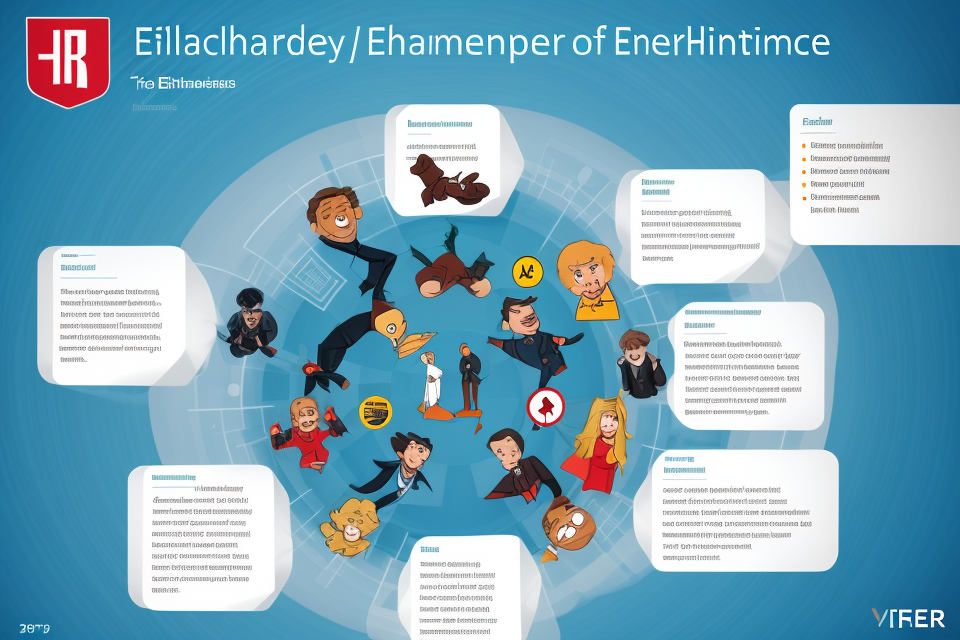Character embodiment is a concept that has gained significant attention in recent years, particularly in the fields of psychology, neuroscience, and cognitive studies. It refers to the phenomenon where individuals assume the perspective, characteristics, and traits of a fictional or non-fictional character, either consciously or unconsciously. This process involves the integration of the character’s qualities into one’s own psyche, resulting in a shift in thoughts, emotions, and behaviors.
Character embodiment can be observed in various forms of media, including literature, film, and video games. It is a powerful tool for storytelling and can evoke strong emotional responses from audiences. However, it is also a topic of debate among scholars, with some arguing that it is a natural cognitive process, while others view it as a form of escapism or manipulation.
This guide aims to provide a comprehensive understanding of character embodiment, exploring its psychological and cognitive underpinnings, its effects on individuals and society, and its potential applications in various fields. By the end of this guide, readers will have a deeper appreciation of the complexities of character embodiment and its impact on our lives.
What is Character Embodiment?
Definition and Explanation
Character embodiment refers to the extent to which a character’s behavior, emotions, and motivations are consistent with their physical appearance, mannerisms, and body language. It is a key aspect of character development in storytelling, as it helps to create a sense of believability and immersion for the audience.
A well-embodied character is one whose physicality and behavior are closely tied, with the character’s appearance and mannerisms reflecting their personality and inner state. For example, a character who is confident and assertive may stand tall, make eye contact, and use open body language, while a character who is anxious and insecure may fidget, avoid eye contact, and slouch.
In addition to enhancing the realism of a character, embodiment can also be used to convey important narrative information. For instance, a character’s posture or facial expressions can reveal their emotional state, even if they are not explicitly stating it through dialogue.
However, it is important to note that character embodiment is not solely determined by physical appearance or mannerisms. A character’s backstory, upbringing, and cultural background can also play a significant role in shaping their embodiment. For example, a character who has experienced trauma may exhibit physical tics or mannerisms as a result of their past experiences.
Overall, character embodiment is a crucial element of storytelling that can help to create rich, nuanced characters that feel authentic and relatable to audiences. By understanding the role of embodiment in character development, writers can enhance the emotional impact of their stories and create more immersive and engaging experiences for their readers.
Importance in Writing and Acting
In writing and acting, character embodiment refers to the process of embodying a character’s thoughts, emotions, and actions through physical movements, facial expressions, and vocal tone. It is an essential aspect of both writing and acting as it brings a character to life and makes them more relatable to the audience.
In writing, character embodiment can help create a more immersive and engaging story. By incorporating a character’s physical movements, facial expressions, and vocal tone, a writer can convey their emotions, thoughts, and actions in a more realistic and relatable way. This helps the reader to better understand the character and their motivations, which in turn creates a stronger emotional connection between the reader and the character.
In acting, character embodiment is crucial for creating a believable and authentic performance. Actors must embody the character’s thoughts, emotions, and actions in order to make the character come to life on stage or screen. This requires a deep understanding of the character’s backstory, motivations, and desires, as well as the ability to convey these emotions and actions through physical movements, facial expressions, and vocal tone.
Overall, character embodiment is essential in both writing and acting as it allows the audience to connect with the character on a deeper level, making the story or performance more engaging and impactful.
Techniques for Achieving Character Embodiment
Developing Physicality
One of the primary techniques for achieving character embodiment is by developing physicality. This involves creating distinctive movements, gestures, and body language that reflect the character’s personality, background, and motivations. By focusing on physicality, an actor can create a character that is both visually and emotionally engaging.
Using Sensory Details
Developing physicality can be enhanced by incorporating sensory details. For example, a character’s sense of touch might reveal their feelings or experiences. A character who has been through a traumatic event might flinch at a particular touch or have a tendency to hold themselves in a protective manner. By incorporating these sensory details, an actor can further develop the character’s embodiment.
Exploring Breath and Voice
Breath and voice are also crucial elements in character embodiment. An actor’s breathing can convey emotions such as anxiety, anger, or fear. By altering the pace and depth of breathing, an actor can subtly change the character’s emotional state. Similarly, the character’s voice can be modified to reflect their background, personality, and current situation. This includes variations in pitch, tone, and accent.
Costume and Makeup
Costume and makeup are additional techniques that can contribute to character embodiment. The right costume can provide physical cues that hint at the character’s background, occupation, or personality. Similarly, makeup can be used to convey a character’s age, health, or emotional state. When combined with physicality and voice, costume and makeup can significantly enhance an actor’s ability to embody a character.
Developing Psychological and Emotional Depth
Another technique for achieving character embodiment is by developing psychological and emotional depth. This involves understanding the character’s motivations, fears, desires, and conflicts. By exploring these psychological aspects, an actor can create a character that feels more realistic and engaging.
Backstory and Personal History
Developing psychological and emotional depth can be achieved by creating a detailed backstory and personal history for the character. This includes exploring the character’s childhood, relationships, and past experiences. By understanding the character’s past, an actor can better understand their present behavior and emotional state.
Creating Internal Conflict
Internal conflict is another key element in character embodiment. This involves creating struggles and challenges that the character must face, both internally and externally. By exploring these conflicts, an actor can create a character that is more dynamic and relatable.
Developing Empathy
Developing empathy is also essential for achieving character embodiment. This involves understanding the character’s perspective and feelings, even if they differ from the actor’s own beliefs or experiences. By developing empathy, an actor can create a character that feels more authentic and emotionally resonant.
Overall, achieving character embodiment requires a combination of physicality, psychological depth, and empathy. By focusing on these techniques, an actor can create a fully realized and engaging character.
Character Embodiment in Literature
Examples in Fiction
- In Jane Austen’s “Pride and Prejudice,” the character of Elizabeth Bennet is an embodiment of wit, independence, and strong-mindedness. Her actions and dialogue reflect her character traits, and her thoughts and feelings are revealed through her behavior.
- In F. Scott Fitzgerald’s “The Great Gatsby,” the character of Jay Gatsby is an embodiment of the American Dream. He is portrayed as a man who has achieved great wealth and status through his own efforts, but his character is also marked by his obsession with the past and his desire to attain an unattainable goal.
- In Harper Lee’s “To Kill a Mockingbird,” the character of Atticus Finch is an embodiment of moral integrity and compassion. He is portrayed as a man who stands up for what is right, even when it is difficult, and who treats others with kindness and respect.
- In Toni Morrison’s “Beloved,” the character of Sethe is an embodiment of the struggles and resilience of African American women. She is portrayed as a woman who has endured great hardship and trauma, but who has also found ways to survive and thrive in the face of adversity.
- In J.K. Rowling’s “Harry Potter” series, the character of Hermione Granger is an embodiment of intelligence and determination. She is portrayed as a student who excels academically and who is fiercely committed to her goals, but who also struggles with her own limitations and vulnerabilities.
In each of these examples, the characters are not only portrayed through their actions and dialogue, but also through their physical appearance, mannerisms, and interactions with other characters. By using these techniques, authors are able to create characters that are fully realized and complex, and that resonate with readers on a deep emotional level.
Analysis of Character Embodiment in Literature
Examining the Depiction of Character Embodiment in Different Literary Genres
One way to analyze character embodiment in literature is to examine how it is depicted in different literary genres. For example, in romance novels, character embodiment may be used to convey the emotional and physical attraction between characters, while in mystery novels, it may be used to create suspense and tension.
Exploring the Role of Character Embodiment in Character Development
Another approach is to analyze how character embodiment contributes to character development. For instance, a character’s physical appearance, mannerisms, and behavior can reveal their personality traits, motivations, and conflicts. This can be seen in works such as Jane Austen’s “Pride and Prejudice,” where the characters’ embodiment is used to convey their social status, gender roles, and relationships.
Investigating the Relationship Between Character Embodiment and Setting
Additionally, it is important to consider the relationship between character embodiment and setting. The setting can influence how a character is perceived and how they present themselves. For example, a character’s clothing and appearance may change depending on the cultural or historical context of the setting. This can be seen in works such as Toni Morrison’s “Beloved,” where the characters’ embodiment is closely tied to their experiences of slavery and their attempts to reclaim their identity.
Evaluating the Effectiveness of Character Embodiment in Creating a Immersive Reading Experience
Lastly, it is useful to evaluate the effectiveness of character embodiment in creating an immersive reading experience. Character embodiment can help readers connect emotionally with the characters and become more invested in the story. However, it is important to note that overuse of character embodiment can become distracting and detract from the overall narrative. This can be seen in works such as George R.R. Martin’s “A Song of Ice and Fire,” where the extensive descriptions of characters’ appearances and mannerisms contribute to the immersive world-building but can also be overwhelming for some readers.
Character Embodiment in Film and Television
Examples of Embodied Characters in Film and Television
When examining the concept of character embodiment in film and television, it is helpful to look at specific examples that illustrate the ways in which characters can be portrayed as fully realized, multidimensional beings. Here are a few examples of embodied characters from film and television:
- The Terminator (1984)
- The Terminator, played by Arnold Schwarzenegger, is a classic example of character embodiment. Through his physical presence, his facial expressions, and his actions, the Terminator embodies the concept of a relentless, destructive force.
- Aliens (1986)
- In Aliens, Sigourney Weaver’s character, Ellen Ripley, is another example of character embodiment. Her physicality, her determination, and her resourcefulness all contribute to the way she is portrayed as a strong, capable protagonist.
- Forrest Gump (1994)
- Forrest Gump, played by Tom Hanks, is a prime example of a character who is fully embodied through his physicality, his facial expressions, and his actions. He is a character who is defined by his innocence, his kindness, and his perseverance.
- The Sopranos (1999-2007)
- In The Sopranos, James Gandolfini’s portrayal of Tony Soprano is a masterclass in character embodiment. Through his physical presence, his facial expressions, and his actions, Gandolfini embodies the complex, conflicted nature of Tony Soprano, a character who is both brutal and vulnerable.
- Game of Thrones (2011-2019)
- In Game of Thrones, the character of Tyrion Lannister, played by Peter Dinklage, is a prime example of character embodiment. Through his physicality, his facial expressions, and his actions, Dinklage embodies the character’s cunning, his vulnerability, and his strength.
These examples illustrate the many different ways in which characters can be embodied in film and television, and how this embodiment can contribute to the viewer’s understanding of the character and their place in the story. By examining these examples in greater detail, we can gain a deeper understanding of the ways in which character embodiment can enhance the viewer’s experience of film and television.
Analysis of Character Embodiment in Film and Television
Examining the Relationship Between Character Embodiment and Audience Perception
One of the primary aspects of analyzing character embodiment in film and television is understanding the relationship between the way a character is portrayed and how the audience perceives them. This includes considering factors such as:
- Body language and facial expressions: Nonverbal cues can greatly impact how an audience interprets a character’s thoughts, emotions, and intentions. For example, a character’s posture, gestures, and facial expressions can communicate their level of confidence, dominance, or vulnerability.
- Costume and makeup: The clothes a character wears and the way they are made up can convey important information about their personality, social status, and even their motivations. For instance, a character dressed in expensive suits may be perceived as wealthy or powerful, while a character in ragged clothing might be seen as poor or disadvantaged.
- Setting and environment: The surroundings in which a character finds themselves can also influence audience perception. For example, a character in a dark, cramped room might be perceived as trapped or claustrophobic, while a character in an open, spacious setting might be seen as free and liberated.
Identifying Techniques Used to Create Character Embodiment
Another key aspect of analyzing character embodiment in film and television is identifying the specific techniques used by filmmakers to create a sense of embodiment. These techniques can include:
- Close-up shots: Using close-up shots of a character’s face or body can create a sense of intimacy and draw the audience’s attention to specific details. This can be particularly effective in conveying emotions or creating a sense of tension.
- Point-of-view shots: Film and television often use point-of-view shots to give the audience a sense of what a character is seeing and experiencing. This can help to create a sense of embodiment by allowing the audience to see the world through the character’s eyes.
- Slow motion: Slowing down the action can create a sense of emphasis and draw attention to specific details. This can be particularly effective in conveying emotions or highlighting a character’s actions.
Assessing the Effectiveness of Character Embodiment
Finally, analyzing character embodiment in film and television involves assessing the effectiveness of the techniques used. This includes considering questions such as:
- Does the character’s embodiment feel authentic and consistent with their personality and circumstances?
- Does the embodiment enhance the audience’s understanding of the character and their motivations?
- Does the embodiment create a sense of empathy or connection with the character?
By answering these questions, filmmakers and audiences can gain a deeper understanding of how character embodiment works and how it can be used to create more engaging and immersive stories.
Character Embodiment in Performance Art
Examples of Embodied Characters in Performance Art
In the realm of performance art, character embodiment plays a crucial role in bringing stories and characters to life. Embodied characters in performance art are those that actors or performers physically embody, bringing their unique qualities and traits to the forefront. This section will explore some examples of embodied characters in performance art.
Brechtian Character Embodiment
One notable example of embodied characters in performance art is the Brechtian character embodiment. Brechtian character embodiment is a technique used in the works of the German playwright and theater practitioner Bertolt Brecht. In this technique, actors play multiple roles, and their characters are portrayed as archetypes rather than realistic portrayals. The goal is to create a distance between the audience and the characters, encouraging the audience to engage with the play’s themes and messages rather than becoming emotionally invested in the characters themselves.
Masked Character Embodiment
Another example of embodied characters in performance art is masked character embodiment. In this technique, actors wear masks or other forms of face coverings to portray their characters. Masked character embodiment allows actors to transform their appearance and take on different personas, while also allowing the audience to focus on the character’s actions and expressions rather than their physical appearance. Masked character embodiment is often used in traditional theater forms such as Commedia dell’arte and in modern productions such as Sondheim’s “Into the Woods.”
Physical Character Embodiment
Physical character embodiment is another example of embodied characters in performance art. This technique involves actors using their bodies and physicality to portray their characters. Actors may use movements, gestures, and facial expressions to convey their characters’ emotions and actions. Physical character embodiment is often used in modern dance and physical theater, where the body is used as a primary tool for storytelling.
Gender-Bending Character Embodiment
Finally, gender-bending character embodiment is an example of embodied characters in performance art. This technique involves actors portraying characters of a different gender than their own. Gender-bending character embodiment challenges traditional gender roles and expectations, allowing actors to explore different aspects of their characters’ personalities and experiences. Gender-bending character embodiment is often used in contemporary theater and performance art, as well as in popular culture, such as in the works of artists like David Bowie and RuPaul.
Overall, embodied characters in performance art provide a powerful way for actors and performers to bring stories and characters to life. By using various techniques such as Brechtian character embodiment, masked character embodiment, physical character embodiment, and gender-bending character embodiment, performers can create rich and complex portrayals of characters that resonate with audiences.
Analysis of Character Embodiment in Performance Art
Examining the Connection Between Character and Physicality
When examining character embodiment in performance art, it is important to consider the connection between the character and their physicality. This includes analyzing how the character’s physical movements, gestures, and expressions contribute to the overall portrayal of the character. By studying this connection, we can gain a deeper understanding of how the performer embodies the character and how the audience perceives the character.
Analyzing the Use of Space and Movement in Performance Art
Another aspect of analyzing character embodiment in performance art is by examining the use of space and movement. This includes analyzing how the performer utilizes the stage or performance space, as well as how they move throughout the space. By examining these elements, we can gain insight into how the performer uses physicality to convey the character’s emotions, thoughts, and actions.
Exploring the Role of Costume and Makeup in Character Embodiment
Costume and makeup play a significant role in character embodiment in performance art. By analyzing the costume and makeup choices, we can gain insight into how the performer embodies the character and how the character is perceived by the audience. This includes examining how the costume and makeup contribute to the overall portrayal of the character, as well as how they affect the performer’s physicality and movement.
Assessing the Audience’s Perception of Character Embodiment
Finally, when analyzing character embodiment in performance art, it is important to consider the audience’s perception of the character. This includes examining how the audience responds to the character, as well as how the character is received by the audience. By studying the audience’s perception of character embodiment, we can gain insight into how effective the performer’s embodiment of the character is, and how it contributes to the overall success of the performance.
Character Embodiment in Psychology
Theories of Character Embodiment in Psychology
In psychology, theories of character embodiment attempt to explain how an individual’s character traits can be reflected in their physical appearance, mannerisms, and overall demeanor. One such theory is the Behavioral Theory of Character Embodiment, which suggests that individuals with certain character traits may exhibit distinct nonverbal cues that betray their true nature. For example, someone who is outgoing and confident may have an upright posture, direct eye contact, and a wide smile, while someone who is shy and introverted may have a more reserved posture, averted gaze, and a limited facial expression range.
Another theory is the Self-Perception Theory of Character Embodiment, which proposes that individuals tend to interpret their own bodily sensations as a reflection of their internal state. According to this theory, an individual’s body language may not necessarily reveal their true character, but rather their attempts to manipulate their own body language in order to project a certain image. For example, someone who is anxious may exhibit physical signs of anxiety, such as fidgeting or avoiding eye contact, but these behaviors may be driven more by a desire to appear confident rather than an actual reflection of their true emotional state.
Finally, the Social Identity Theory of Character Embodiment suggests that an individual’s physical appearance and behavior may be shaped by the social groups to which they belong. According to this theory, an individual’s nonverbal cues may be influenced by the norms and expectations of their social group, and may change depending on the context in which they find themselves. For example, a member of a dominant social group may exhibit more confident and assertive body language when interacting with members of a subordinate group, while a member of a subordinate group may exhibit more submissive and deferential body language when interacting with members of a dominant group.
Overall, these theories of character embodiment highlight the complex interplay between an individual’s personality traits, their physical appearance and behavior, and the social context in which they operate. By understanding these dynamics, we can gain insights into how we present ourselves to others, and how we interpret the nonverbal cues of those around us.
Examples of Embodied Characters in Psychology
1. Avatar Therapy
In avatar therapy, patients with mental health issues such as schizophrenia or bipolar disorder create an embodied character, known as an avatar, which represents their ideal self. The patient then interacts with this avatar in therapy sessions, using role-playing and other techniques to embody the character’s positive traits and behaviors. By doing so, the patient can learn to internalize these qualities and develop a more positive self-image.
2. Superhero Therapy
Superhero therapy is another form of embodied therapy that uses fictional characters to help patients overcome emotional and psychological challenges. In this approach, patients create their own superhero alter ego, which they can use to confront and overcome their personal struggles. For example, a patient who struggles with anxiety might create a superhero character who is brave and confident, and then use role-playing and other techniques to embody these qualities and overcome their fears.
3. Drama Therapy
Drama therapy is a form of psychotherapy that uses role-playing and other theatrical techniques to help patients explore and resolve emotional issues. In this approach, patients may be asked to embody different characters or personas, using their bodies, voices, and facial expressions to bring these characters to life. By doing so, patients can gain insight into their own emotions and behaviors, and learn to communicate more effectively with others.
4. Embodied Cognition
In the field of embodied cognition, researchers have found that our thoughts and emotions are closely tied to our bodily experiences. For example, studies have shown that when people are asked to think about their physical sensations, such as their posture or facial expressions, they are more likely to make accurate judgments about other people’s emotions. This suggests that our emotions are not just abstract mental states, but are closely tied to our bodily experiences and expressions.
5. Character Analysis
In literary analysis, characters are often analyzed for their embodied qualities, such as their physical appearance, gestures, and expressions. For example, in Shakespeare’s plays, characters’ physical characteristics and actions often reveal important insights into their personalities and motivations. By analyzing these embodied qualities, readers can gain a deeper understanding of the characters and the themes of the play.
Analysis of Character Embodiment in Psychology
In the field of psychology, character embodiment refers to the psychological processes through which individuals project their consciousness onto their physical bodies, and the way in which their physical bodies influence their psychological states.
Physical States and Psychological States
Research in embodied cognition suggests that the physical states of the body can influence psychological states. For example, research has shown that physical states such as posture, facial expressions, and body language can affect a person’s emotional state. In turn, a person’s emotional state can also influence their physical states.
Embodied Cognition
Embodied cognition is the theory that cognitive processes are grounded in the body’s interactions with the environment. This theory suggests that the body plays an important role in shaping the mind and that cognitive processes are not purely abstract but are also influenced by the body’s experiences.
The Body’s Role in Social Interaction
Social interaction is also influenced by the body. Nonverbal communication, such as body language and facial expressions, plays a significant role in social interaction. Research has shown that nonverbal communication can influence the way people perceive others and the way they perceive themselves.
The Body’s Role in Emotion Regulation
The body also plays a role in emotion regulation. For example, research has shown that physical exercise can have a positive effect on mood and anxiety levels. Similarly, physical touch, such as hugging or holding hands, can have a positive effect on emotional well-being.
In summary, the analysis of character embodiment in psychology highlights the complex interplay between the body and the mind. It suggests that the body plays an important role in shaping the mind, influencing cognitive processes, social interaction, and emotion regulation. Understanding the role of character embodiment in psychology can provide valuable insights into human behavior and can be used to develop more effective interventions for mental health and well-being.
Techniques for Teaching Character Embodiment
Exercises for Developing Character Embodiment
Introduction
Character embodiment refers to the process of creating a believable and relatable character that can engage an audience emotionally. This is a crucial aspect of any form of storytelling, including literature, film, and theater. In order to develop a character that is truly embodied, it is important to engage in specific exercises that focus on physicality, voice, and movement.
Physicality Exercises
Physicality exercises are designed to help actors or writers connect with their characters on a physical level. These exercises often involve movement and physical activity, such as dance or yoga, which can help to build strength, flexibility, and balance. Some examples of physicality exercises include:
- Improvisation: Improvisation is a powerful tool for developing character embodiment. By engaging in improvisational exercises, actors can explore different physicalities and movements associated with their characters. This can help to build a deeper understanding of the character’s motivations, desires, and fears.
- Voice Work: Voice work is another important aspect of character embodiment. By working on vocal techniques such as breathing, articulation, and projection, actors can develop a more authentic and believable voice for their characters. This can include exploring different accents, pitches, and tone colors.
- Movement: Movement is a key component of character embodiment. By engaging in movement exercises such as dance or martial arts, actors can develop a more physical connection to their characters. This can help to build a deeper understanding of the character’s physicality, including their posture, gait, and gestures.
Voice Exercises
Voice exercises are designed to help actors or writers develop a more authentic and believable voice for their characters. These exercises often involve breathing, articulation, and projection techniques, which can help to build a more dynamic and expressive voice. Some examples of voice exercises include:
- Breathing: Breathing exercises are an important component of voice work. By focusing on deep, controlled breaths, actors can develop a more resonant and powerful voice. This can include exercises such as diaphragmatic breathing, which involves breathing deeply into the diaphragm.
- Articulation: Articulation exercises are designed to help actors develop clear and precise enunciation. This can include exercises such as tongue twisters, which can help to build articulation and precision.
- Projection: Projection exercises are designed to help actors develop a more powerful and expressive voice. This can include exercises such as shouting and projection, which can help to build strength and confidence in the voice.
Movement Exercises
Movement exercises are designed to help actors or writers develop a more physical connection to their characters. These exercises often involve movement and physical activity, such as dance or martial arts, which can help to build strength, flexibility, and balance. Some examples of movement exercises include:
- Dance: Dance is a powerful tool for developing character embodiment. By engaging in dance exercises such as hip-hop or contemporary, actors can develop a more physical connection to their characters. This can help to build a deeper understanding of the character’s physicality, including their posture, gait, and gestures.
- Martial Arts: Martial arts are another important aspect of character embodiment. By engaging in martial arts exercises such as karate or taekwondo, actors can develop a more physical connection to their characters. This can help to build a deeper understanding of the character’s physicality, including their strength, agility, and balance.
Techniques for Directing and Acting Embodied Characters
- Preparation
- Understanding the character’s backstory, motivations, and goals
- Studying the script and analyzing the character’s dialogue and actions
- Physical and vocal warm-ups to prepare the body and voice
- Acting Techniques
- Mindfulness: focusing on the present moment and staying in the character’s reality
- Improvisation: exploring different ways to approach a scene or situation
- Emotional Recall: accessing personal memories and emotions to fuel the character’s reactions
- Physicalization: using body language, posture, and movement to convey the character’s emotions and thoughts
- Vocal Work: developing the character’s voice and accent, as well as exploring different tones and inflections
- Directing Techniques
- Collaboration: working closely with actors to understand their interpretation of the character and incorporating their ideas into the performance
- Communication: clearly conveying the vision for the character and the scene to the actors
- Critique: providing constructive feedback to actors to help them improve their performance
- Blocking: arranging the placement of actors and props on stage to create a visually engaging and emotionally impactful performance
- Transitions: smoothly moving actors from one scene to the next, and from one emotion to the next, to maintain the flow of the performance.
Analysis of Techniques for Teaching Character Embodiment
In order to effectively teach character embodiment, it is important to analyze and understand the various techniques that can be used. These techniques can range from physical movement exercises to role-playing and improvisation. By examining each technique, it is possible to determine which ones may be most effective for a particular group of students or for a specific character or scene.
One technique for teaching character embodiment is physical movement exercises. These exercises can involve movement of the body in response to the character’s thoughts, emotions, and actions. For example, a character who is angry may pace back and forth, while a character who is sad may slump their shoulders and look down. By having students perform these movements, they can begin to embody the character’s emotions and actions in a physical way.
Another technique is role-playing and improvisation. This involves having students act out scenes or situations as the character they are portraying. This can help students to understand the character’s motivations, thoughts, and actions in a more immediate and intuitive way. By experiencing the character firsthand, students can begin to embody the character in a more complete and nuanced way.
In addition to these techniques, there are also other methods that can be used to teach character embodiment. These can include voice and speech work, which can help students to develop the character’s unique voice and speech patterns. Another method is to use imagery and visualization, which can help students to create a mental image of the character and their surroundings.
Ultimately, the most effective technique for teaching character embodiment will depend on the needs and abilities of the students, as well as the specific character or scene being portrayed. By analyzing and understanding the various techniques available, it is possible to determine which ones will be most effective for a particular group of students or for a specific character or scene.
Character Embodiment in Modern Media
Examples of Embodied Characters in Modern Media
- The Avengers franchise, specifically the character of Iron Man, portrayed by Robert Downey Jr., is a prime example of character embodiment in modern media.
- Iron Man’s character embodies the idea of a tech-savvy genius who uses his intelligence and resources to protect the world.
- The audience experiences a sense of power and control through Iron Man’s character, as they can relate to his intelligence and resourcefulness.
- The character of Katniss Everdeen in The Hunger Games franchise, played by Jennifer Lawrence, is another example of character embodiment in modern media.
- Katniss’s character embodies the idea of a strong, independent woman who is willing to do whatever it takes to protect her loved ones.
- The audience experiences a sense of strength and determination through Katniss’s character, as they can relate to her unwavering dedication to her loved ones.
- The character of Harry Potter in the Harry Potter franchise, played by Daniel Radcliffe, is another example of character embodiment in modern media.
- Harry’s character embodies the idea of a young person with a unique destiny who must navigate a world of magic and danger.
- The audience experiences a sense of adventure and excitement through Harry’s character, as they follow him on his journey to fulfill his destiny.
- The character of Walter White in Breaking Bad, played by Bryan Cranston, is another example of character embodiment in modern media.
- Walter’s character embodies the idea of a man who is pushed to his limits and must resort to extreme measures to provide for his family.
- The audience experiences a sense of moral ambiguity and complexity through Walter’s character, as they grapple with the consequences of his actions.
Analysis of Character Embodiment in Modern Media
In the contemporary media landscape, character embodiment has become a significant aspect of storytelling. This analysis aims to examine the various techniques employed by creators to convey the embodiment of characters in modern media.
The Role of Visual Representation
One of the primary methods used to convey character embodiment is through visual representation. In films, television shows, and video games, the physical appearance of characters, including their body language, facial expressions, and movements, play a crucial role in conveying their inner thoughts and emotions. For instance, the character “Iron Man” in the Marvel Cinematic Universe (MCU) embodies the character’s intelligence, confidence, and determination through his suave appearance and powerful movements.
Dialogue and Inner Monologues
Another way in which character embodiment is conveyed is through dialogue and inner monologues. The words and thoughts of characters can provide insight into their innermost feelings and beliefs, which in turn, help to shape their actions and behaviors. In the novel “To Kill a Mockingbird” by Harper Lee, the protagonist Scout’s thoughts and dialogue convey her innocence, curiosity, and growing understanding of the world around her.
Narrative Techniques
Narrative techniques such as point-of-view (POV) and camera angles can also influence the way in which characters are embodied in modern media. For example, in the TV show “Breaking Bad,” the use of close-up shots and tight framing emphasizes the inner turmoil of the main character, Walter White, as he transforms from a mild-mannered high school chemistry teacher into a ruthless drug kingpin.
Interaction with Other Characters
Finally, the interactions between characters can also provide insight into their embodiment. The way in which characters respond to one another, including their tone of voice, body language, and facial expressions, can reveal their inner thoughts and emotions. In the play “Romeo and Juliet,” the tension between the two titular characters in Act 1, Scene 5, highlights their passion and intensity, which are embodied through their dialogue and body language.
In conclusion, character embodiment in modern media is a complex and multifaceted concept that can be conveyed through various techniques, including visual representation, dialogue, narrative techniques, and interaction with other characters. Understanding these techniques can provide a deeper appreciation of the art of storytelling and the ways in which creators can convey complex emotions and ideas through the embodiment of their characters.
The Future of Character Embodiment
Predictions for the Evolution of Character Embodiment
As technology continues to advance, the way we experience and interact with characters in various forms of media is expected to change significantly. Here are some predictions for the evolution of character embodiment:
- Increased use of AI and Machine Learning: The integration of AI and Machine Learning into character embodiment is expected to become more prevalent. This will allow for more advanced and realistic character behavior, as well as the ability to create personalized experiences for individual users.
- Virtual Reality and Augmented Reality: As VR and AR technologies become more mainstream, it is likely that character embodiment will play a significant role in these platforms. Users will be able to fully immerse themselves in virtual worlds and interact with characters in a more realistic and intuitive way.
- More Personalized Characters: With the rise of big data and the ability to collect vast amounts of user information, it is likely that characters will become more personalized and tailored to individual users. This could include characters that change their behavior and appearance based on user preferences and interactions.
- Increased Focus on Emotional Intelligence: As characters become more advanced, there will be a greater focus on emotional intelligence and the ability to understand and respond to the emotions of users. This will create more realistic and engaging character experiences.
- Greater Use of Biometric Data: The use of biometric data, such as heart rate and skin conductance, may become more prevalent in character embodiment. This will allow for characters to respond to user emotions in real-time, creating a more immersive experience.
- Integration with Social Media: Characters may become more integrated with social media, allowing for users to interact with them across multiple platforms and share their experiences with others. This will create more social and interactive character experiences.
Overall, the future of character embodiment is expected to be shaped by advances in technology and the growing demand for more personalized and engaging experiences. As these predictions come to fruition, it will be exciting to see how character embodiment continues to evolve and shape the way we interact with and experience media.
Implications for Writing, Acting, Film, Television, Performance Art, and Psychology
Character embodiment has significant implications for various fields, including writing, acting, film, television, performance art, and psychology. Here’s a closer look at each of these areas:
Writing
For writers, understanding character embodiment can lead to more nuanced and realistic portrayals of characters. By incorporating physicality and nonverbal communication into their writing, authors can create a deeper sense of emotional connection between readers and characters. This can result in more engaging and immersive stories that resonate with readers on a visceral level.
Acting
In the world of acting, character embodiment is crucial for creating believable and compelling performances. Actors must understand the physicality and nonverbal communication of their characters to effectively portray their emotions and motivations. By mastering character embodiment, actors can bring their characters to life in a way that captivates audiences and drives the narrative forward.
Film and Television
In film and television, character embodiment plays a vital role in storytelling. Directors and cinematographers must work closely with actors to capture the physicality and nonverbal communication of their characters on screen. By doing so, they can create a more immersive viewing experience that draws audiences into the story and keeps them engaged from beginning to end.
Performance Art
In the realm of performance art, character embodiment is essential for creating thought-provoking and powerful pieces. Performance artists must understand the physicality and nonverbal communication of their characters to effectively convey their messages and engage their audiences. By mastering character embodiment, performance artists can create works that challenge and inspire their viewers.
Psychology
Finally, character embodiment has significant implications for psychology. Research has shown that the way we think about and perceive others is heavily influenced by their physical appearance and nonverbal communication. By understanding the psychological impact of character embodiment, psychologists can develop more effective interventions and treatments for a range of mental health issues. Additionally, character embodiment can provide valuable insights into the human experience and help us better understand the complexities of social interaction.
Analysis of the Future of Character Embodiment
The future of character embodiment holds immense potential for growth and innovation. With advancements in technology, the integration of virtual reality and artificial intelligence, the way we experience and interact with characters is set to evolve significantly. Here are some key areas of focus:
Integration of Virtual Reality
Virtual reality (VR) has the potential to revolutionize character embodiment by allowing users to fully immerse themselves in a digital world. This technology can be used to create highly interactive and engaging experiences, where users can explore virtual environments and interact with characters in real-time. VR technology can be used to create more complex and detailed character embodiment experiences, with more nuanced movements and interactions.
Incorporation of Artificial Intelligence
Artificial intelligence (AI) can play a significant role in the future of character embodiment. By incorporating AI, characters can become more dynamic and responsive to user actions, creating a more personalized and engaging experience. AI can also be used to create more realistic and human-like behavior in characters, making the experience more immersive and engaging.
Expansion of Character Types
As technology advances, we can expect to see a wider range of characters and character types in embodied experiences. This includes not only human characters but also non-human characters such as animals, robots, and even fictional creatures. This expansion of character types will allow for more diverse and creative storytelling, providing users with unique and engaging experiences.
Accessibility and Inclusivity
In the future, it is important to ensure that character embodiment experiences are accessible and inclusive to all users. This includes ensuring that the technology used is compatible with assistive devices and that the experiences are designed with accessibility in mind. Additionally, it is important to ensure that the characters and storylines are diverse and representative of all communities, promoting inclusivity and diversity in the industry.
In conclusion, the future of character embodiment holds significant potential for growth and innovation. With advancements in technology, we can expect to see more complex and engaging experiences, wider character types, and a focus on accessibility and inclusivity. The future of character embodiment is exciting and holds endless possibilities for the industry.
FAQs
1. What is character embodiment?
Character embodiment refers to the process of bringing a fictional character to life on stage or screen through physical performance. It involves the actor embodying the character’s personality, motivations, and emotions, and using their body language, voice, and movement to create a believable and engaging portrayal.
2. Why is character embodiment important in performance?
Character embodiment is important in performance because it allows the audience to connect with the character on a deeper level. When an actor fully embodies a character, it creates a sense of realism that draws the audience into the story and makes them invested in the character’s journey. It also allows the actor to convey the character’s emotions and thoughts through nonverbal cues, adding depth and complexity to the performance.
3. How does an actor embody a character?
An actor embodies a character by researching the character’s background, motivations, and emotions, and using that information to inform their performance. They may also work with a director or drama coach to develop the character’s physicality, voice, and movement style. The actor then uses these tools to create a believable and engaging portrayal of the character on stage or screen.
4. What are some common challenges in character embodiment?
Some common challenges in character embodiment include finding the right balance between the character’s personality and the actor’s own personality, conveying the character’s emotions and thoughts through nonverbal cues, and staying true to the character’s backstory and motivations throughout the performance. Additionally, the actor must be able to adapt to the demands of the script and the director’s vision while still maintaining a sense of authenticity in their portrayal of the character.
5. How can an actor improve their character embodiment skills?
An actor can improve their character embodiment skills by continuing to research and study the craft of acting, working with a coach or mentor, and seeking out opportunities to perform and hone their skills. They can also learn from other actors and study the performances of seasoned professionals to gain insight into the different techniques and approaches used to embody a character. Ultimately, the key to improving character embodiment skills is to remain open to learning and growth, and to approach each performance with a sense of curiosity and dedication.









